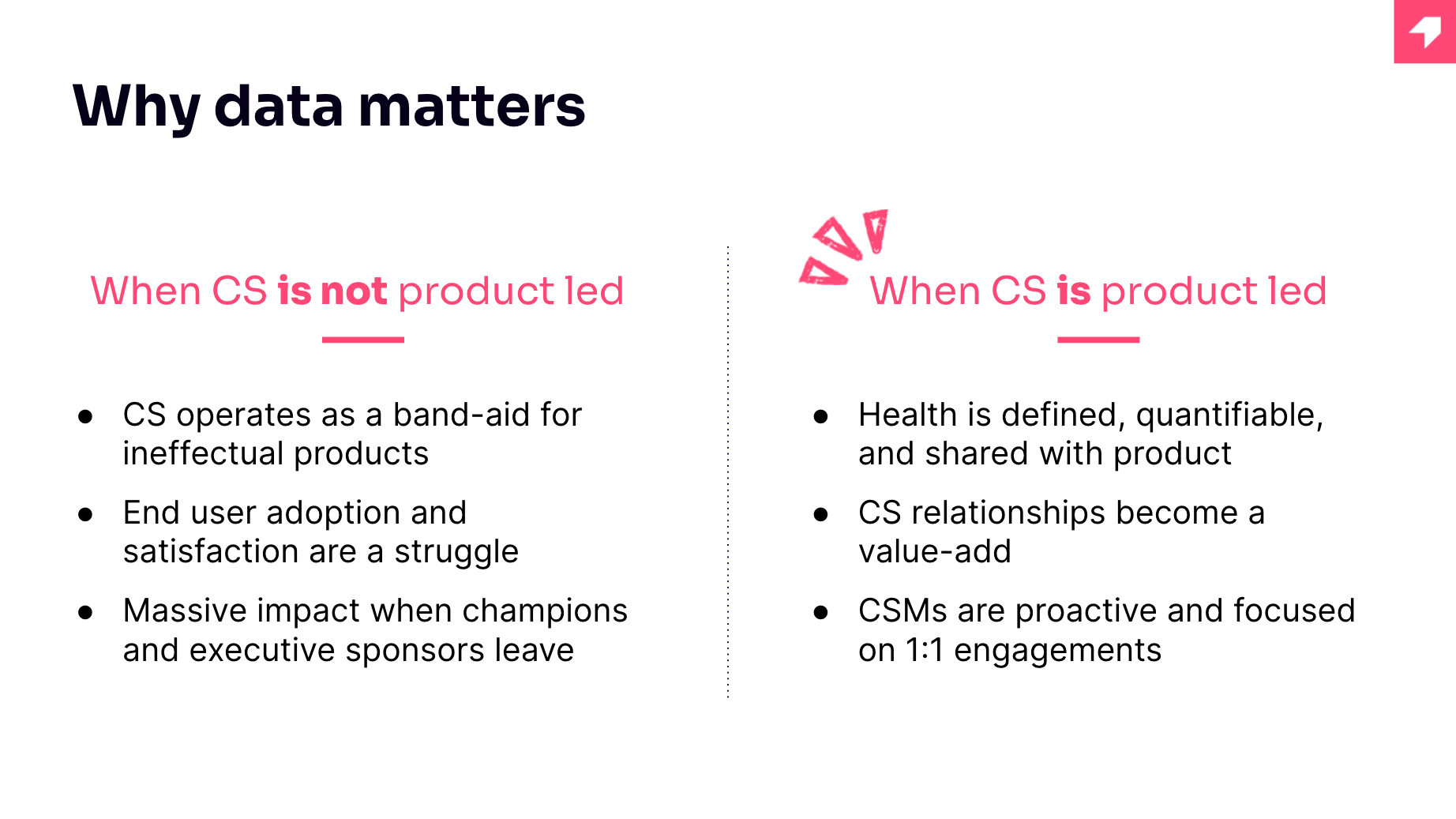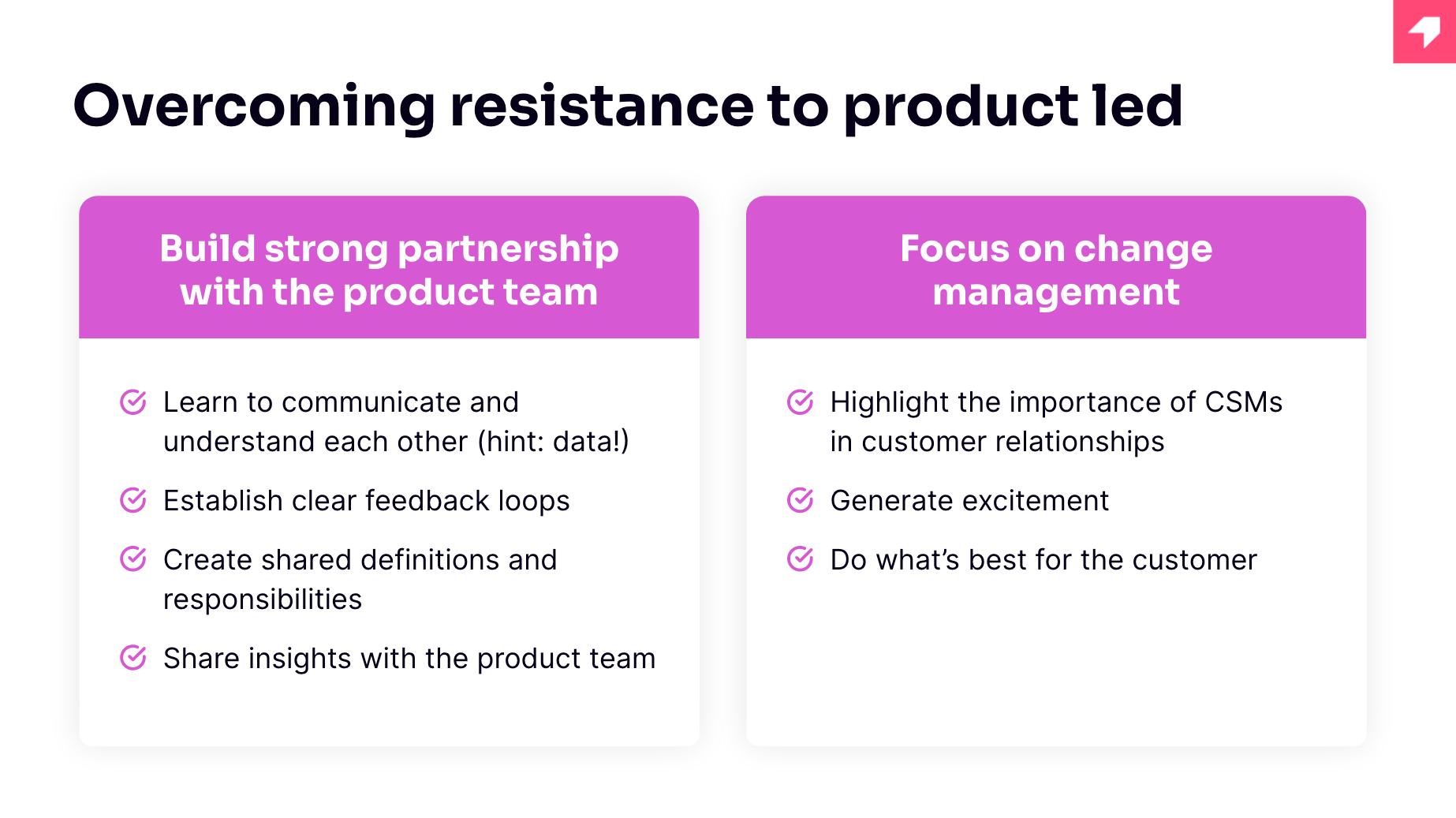As technology has become more pervasive in all areas of our lives, our expectations of the digital experiences they deliver have grown, too. Many of the products we know and love—from streaming services to social media apps—started as digitally native tools built to surprise and delight us. But historically, we haven’t always set the same high bar for our business software.
Today, customers are different. They expect more from the digital products they rely on—and the teams who build and support them. And in a world where it’s easy for customers to switch vendors at a moment’s notice, the organizations who build experiences and engagements to suit these elevated user preferences are winning.
In part two of our “Driving product-led transformation” webinar series, Ben Carey (Chief Customer Officer, Pendo), Abby Hammer (Chief Customer Officer and Head of Products, ChurnZero) and Alaina Loori (Director of Customer Success Operations, HackerRank) sat down to discuss the impact of this changing customer landscape on the customer success (CS) function. They talked about what it means to be a product-led CS team, how product-led strategies have evolved the role of the customer success manager (CSM), and shared guidance and best practices to help CS teams leverage product-led principles at each stage of the customer journey.
Read on for the recap of their conversation, or scroll to the bottom of the page to watch the recording.
How customers have changed
Some estimates indicate that the average American spends about eight hours a day in front of a screen—the majority of which is spent interacting with software. If we’re spending all this time with software, shouldn’t it function the way we want it to, delight us at every turn, and add meaningful value to our lives?
Thanks to the shift to the cloud and the prevalence of subscription models, the power is now in the hands of customers when it comes to software. In addition to functionality that helps them achieve their goals, they want products that give them:
- The ability to self-serve, so they don’t need to wait for hands-on help from a support team (plus the ability to access additional resources whenever they need them)
- A high degree of personalization and customization, so their experiences feel tailored to their specific needs
- Experiences and features that evolve with them, so they feel confident that your offerings will support them as their business, the market, or the world shifts
Today, the ability to delight customers isn’t a differentiator—it’s table stakes. And the relationships customers have with their vendors and account managers are table stakes, too. As Abby put it, “relationships are no longer the foundation on which you want to build your house.” As SaaS models have made purchasing, renewing, and moving away from products easier—and as people leave companies more frequently amidst the Great Resignation—data has become a much more valuable linchpin in sustaining successful partnerships.
Finally, customers also expect a higher degree of domain expertise from the companies and vendors they work with. They want to feel supported and guided not only by the CSMs and relationship managers they interact with, but also by the product itself—through access to strategic insights and resources that empower them to make better business decisions.
What it means to be a product-led customer success team
Becoming product led isn’t something that happens overnight. It’s important to invest in the right tools and teams to create sustainable frameworks and build the right muscles to make product-led practices part of the DNA of your organization. In the same way product operations can help align cross-functional teams and improve processes around the product, customer success operations (or CS operations) can do the same for CS teams hoping to become product led.
In her role as a director of CS operations at HackerRank, Alaina explained that she and her team help encourage product-led behaviors throughout the CS org by developing scalable and repeatable processes, overseeing tooling development to maximize automation and efficiency, and creating scorecards and analytics to empower CSMs with data. She also noted that functions like technical support, customer training and enablement, and scaled CS all roll up into her team—which fosters a high degree of cross-functional collaboration.
Ben highlighted a few areas in particular where a product-led approach lends itself well to CS activities:
- オンボーディング
- Augmenting human-led motions with product-led onboarding, targeted to specific users and their jobs to be done
- Customer education
- Using product data to spot where customers are struggling, then reaching them with in-app guidance or 1:1 support when they need it most
- Interventions
- Looking for “anti-patterns” in customers’ product usage to see where they’re getting stuck or to nudge them to specific areas of the app that will help them be successful
- センチメント
- Collecting customer feedback and sentiment data, particularly at key milestones or following service engagements to expose actionable insights to the right teams
Starting with a firm foundation of product data is a critical component of becoming product led. Abby noted that without data that illuminates how customers are engaging with the product, businesses can’t truly be intentional about their product development or customer engagement strategies. She also noted that it’s critical for both CS and product to work from the same set of data and align around a shared understanding of customer behaviors or risks to help unify the customer experience and keep both groups tracking towards the same goals.
How becoming product led has impacted the role of the CSM
As Todd Olson (CEO and Co-Founder, Pendo) noted during our last webinar in this series, product led ≠ humanless. Ben further expanded on this point—noting that product-led strategies aren’t here to eliminate the role of the CSM, but rather to empower CSMs to provide better service to their customers. Becoming product led frees up CSMs to spend more time delivering hands-on assistance and consultative guidance to high-value accounts, and less time slogging through high-volume, low-impact activities.
Becoming product led also empowers CSMs with a solid foundation of product data. Gaining a clear line of sight into customer behavior data is especially important for CS teams who have historically relied heavily on anecdotal feedback and been forced to make decisions based on gut-feel alone. It gives them a stronger voice in the product’s direction, and empowers them to have more informed conversations with their customers—which can ultimately drive growth and long-term loyalty.
Adopting a product-led strategy also allows CSMs to:
- Deliver more personalized customer communications and guidance
- Focus on delivering value to high-touch accounts
- Send more targeted, data-informed outreach
- Build more rewarding and strategic partnerships
- Gain clear visibility into customer feedback and sentiment
- Better collaborate with the product team to drive product innovation
This last point about cross-functional collaboration is particularly important, and is generally the biggest obstacle CS teams face in their journey to becoming product led. Abby suggested positioning such a partnership to any skeptics through the lens of “Here’s what’s in it for you.” She also encouraged CS leaders to leverage change management tools and tactics to generate excitement for product-led strategies within the CS org.
Further reading
If you’d like to learn more about becoming product led and see how product-led CS strategies can improve your customer experience, visit the Product-led Hub.
And to hear more from Ben, Abby, and Alaina about how they bring product-led approaches to their CS teams, watch the full recording of their conversation below.


![[object Object]](https://cdn.builder.io/api/v1/image/assets%2F6a96e08774184353b3aa88032e406411%2F16b6f2565d1d4a5585db322386f9be7f?format=webp)
![[object Object]](https://cdn.builder.io/api/v1/image/assets%2F6a96e08774184353b3aa88032e406411%2F728d67faa5f64299b8f8f0b138881fb5?format=webp)
![[object Object]](https://cdn.builder.io/api/v1/image/assets%2F6a96e08774184353b3aa88032e406411%2Fc08c4160a2724c4fa3d365eb43791b09?format=webp)
